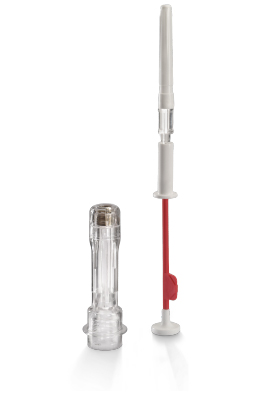Let us rewind back to 1988: the world dances to the songs of Michael Jackson. The World Wide Web known as the Internet experiences its first virus epidemic. The first digital camera is presented, which – what a sensation! – offers storage space for up to ten photos. And Harro Höfliger receives the first order for the HH20 assembly machine, which is to be delivered to Macclesfield.

In the course of more than 30 years, the syringe design for AstraZeneca’s successful product has been modified several times.
The machine automatically opens the pre-assembled syringes, checks the depot length and presence, inserts the delicate implant containing the active ingredient, closes the syringes and transports them to the removal point. 20 high-quality syringes per minute are produced in this way – a major step forward compared to the previously purely manual production.
Inserting the brittle depot manually into a syringe was a tricky, time-consuming operation. 24 pre-assembled syringes arrived in a tray to the “Grade A” laminar airflow cabinet. The operator removed a single syringe, separated the top and bottom halves, measured the depot in a template, inserted it into the bottom half of the syringe using forceps, reassembled the syringe, closed and sealed it in a table mounted jig. The wrap-around self-adhesive label was also applied by hand. The syringe was then passed to the next station for hand insertion into a pouch and subsequent final sealing.
The challenge of aseptic production
The product at that time was still an oncology product of former British chemical giant ICI (Imperial Chemical Industries). The implant releases the active substance over a period of around four weeks as it dissolves within the body. Wolfgang M. Rauch, founder of Raupack Ltd., which was to become a 100 percent subsidiary of Harro Höfliger in 2012, recalls initial talks with ICI in the summer of 1988. “We manufactured a rig for separating and sorting the approximately 10 mm long depots and presented a successful station in autumn.”
This was a milestone because it was the first aseptic project in Harro Höfliger‘s history and it was to lay the foundation for today‘s profound know-how in the field of sterile production. With the HH20, the operator loaded the tray and all 24 syringes were automatically removed and processed one after the other. Following on from the success of the HH20 Syringe Filling & Assembly Machine, Harro Höfliger went on to develop an automated pouch filling and sealing system, a cartoner with a feeding and sealing station and an automated labelling system: a complete turnkey line was created.
This is how the HH20 and HH60 lines worked:
Raupack drew up the requirement specifications for ICI and later the first validation and qualification documentation. Here, too, Harro Höfliger broke completely new ground. In close cooperation with ICI, the necessary documentation was developed for presentation to the regulatory authorities. “When he saw the documentation package, company founder Harro Höfliger’s comment was that it weighed nearly as much as the equipment itself. He said that his company was in the business of building machines, not paper mountains,” recalls Dr. Neil Calder of HH Packaging Systems Ltd. with a smile. “Little did we know back then, how important the validation and qualification package would become to supplying equipment into the pharmaceutical industry.”
When ICI transferred all of its pharmaceutical business to the Zeneca Group in 1993, Harro Höfliger had already supplied four HH20 lines. In 1999, when Zeneca merged with the Swedish company Astra, the number of machines had increased by several more lines.
State-of-the-art
In view of the ever stricter regulatory requirements for aseptic production, and as the product was increasing worldwide sales, AstraZeneca and Harro Höfliger were faced with the challenge of developing a new, faster generation of equipment. A walk-in laminar airflow unit was devised.
In 1992 the HH60 was born, a state-of-the-art line for fully automatic filling, assembly, labelling, pouching, and packaging targeting 60 syringes per minute. It took into account modern aseptic processing, reducing the risk of microbial contamination by separating the operating staff from critical areas of manufacture. A total of four HH60 lines have been supplied to AstraZeneca and these turnkey lines have gone on to produce millions of filled syringes.
Over three decades, the syringe design has been modified several times due to regulatory requirements. One example is the syringe shield, which is designed to counteract the hazard of needle-stick injury. All HH60s were successfully converted to incorporate this new technology.

The next generation of the turnkey line for filling, assembling, pouching, sealing and labelling of the syringes will feature closed barrier technology with VHP decontamination.
30+ years of partnership
Harro Höfliger is also involved in the next generation of equipment to support production at Macclesfield. This involves a new state-of-the-art line, including closed Restricted Access Barrier System (cRABS) technology, incorporating integrated decontamination with vaporized hydrogen peroxide (VHP). Automatic inline 100% leak testing of the “final sterile barrier sealed pouch” will be carried out to ensure that the line meets the highest standard of sterile production for years to come.
Harro Höfliger in conjunction with AstraZeneca are striving to ensure that patients all over the world continue to be supplied with Zoladex.
AstraZeneca
About AstraZeneca
![]() AstraZeneca is a global biopharmaceutical company that focuses on the discovery, development and commercialisation of medicines, primarily for the treatment of diseases in three therapy areas: Oncology; Cardiovascular, Renal & Metabolism, and Respiratory & Immunology. Based in Cambridge, UK, AstraZeneca operates in over 100 countries and its innovative medicines are used by millions of patients worldwide.
AstraZeneca is a global biopharmaceutical company that focuses on the discovery, development and commercialisation of medicines, primarily for the treatment of diseases in three therapy areas: Oncology; Cardiovascular, Renal & Metabolism, and Respiratory & Immunology. Based in Cambridge, UK, AstraZeneca operates in over 100 countries and its innovative medicines are used by millions of patients worldwide.
Download this article as PDF file
Photos: Helmar Lünig


